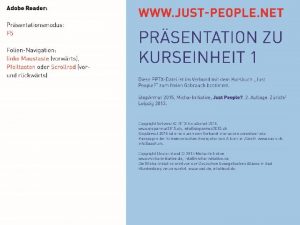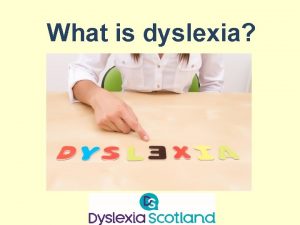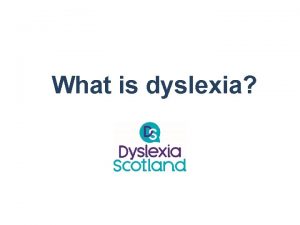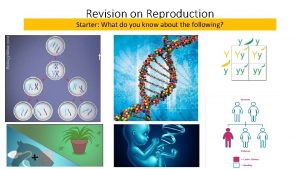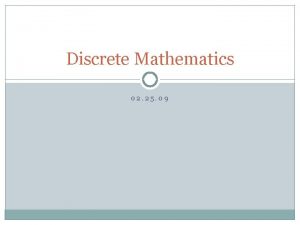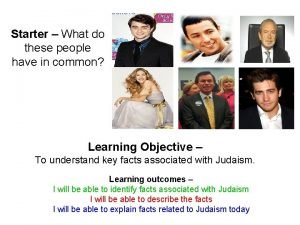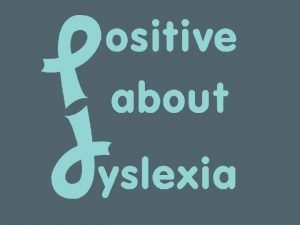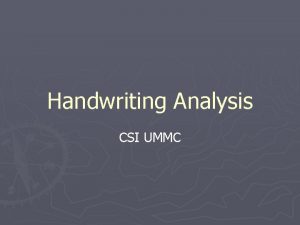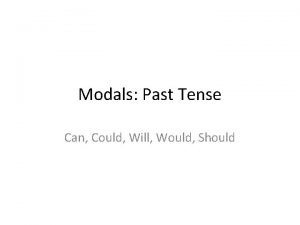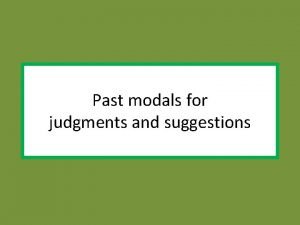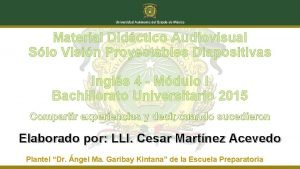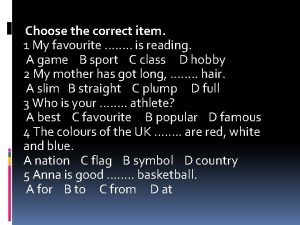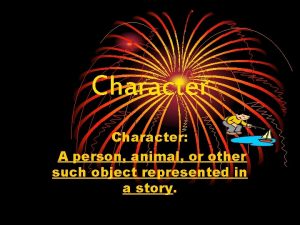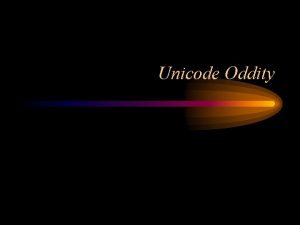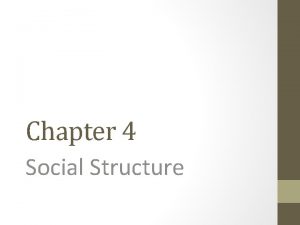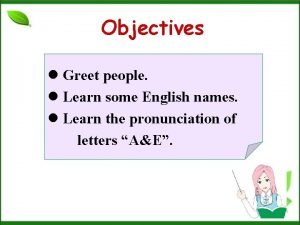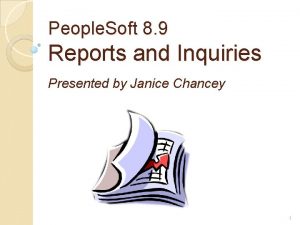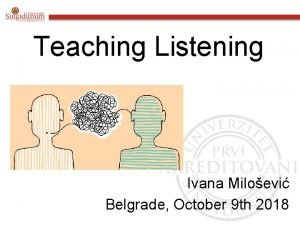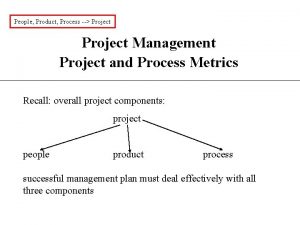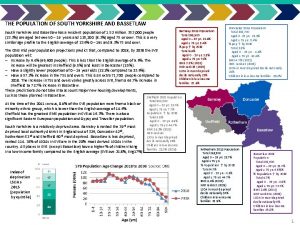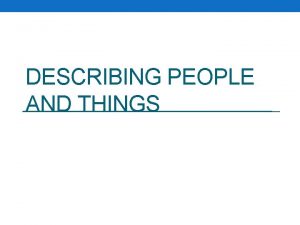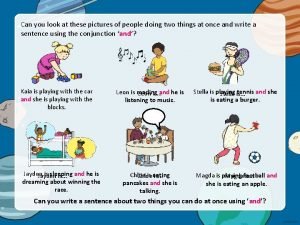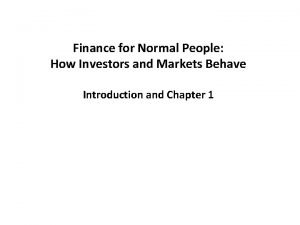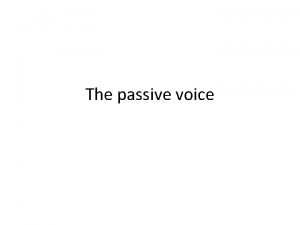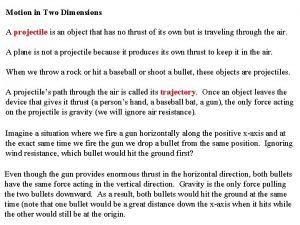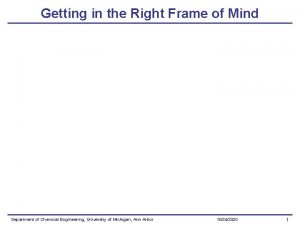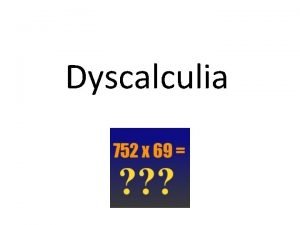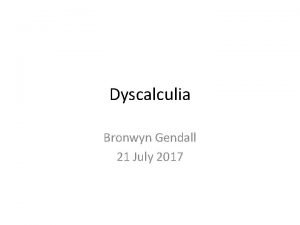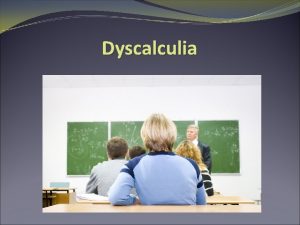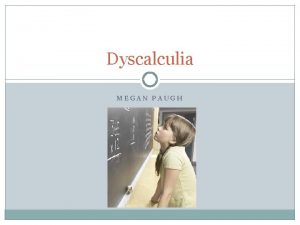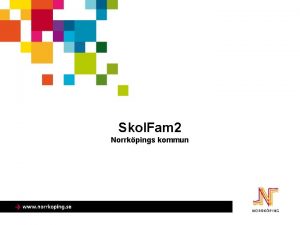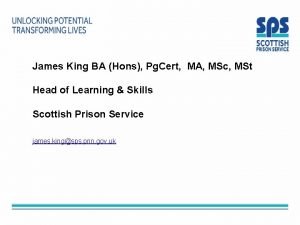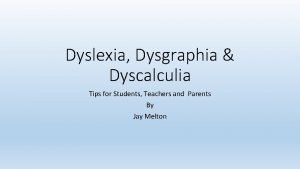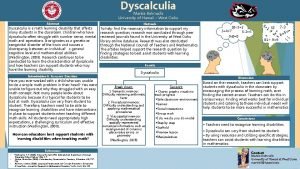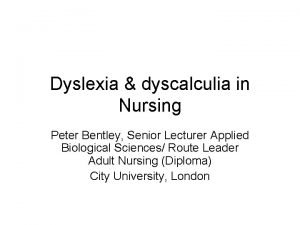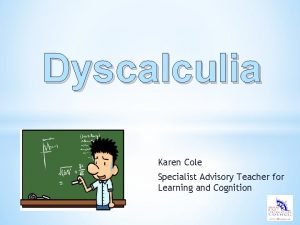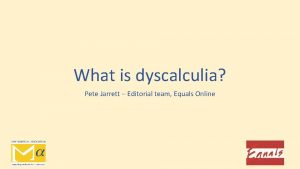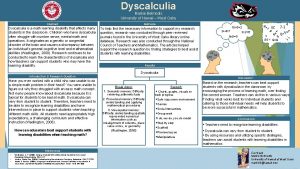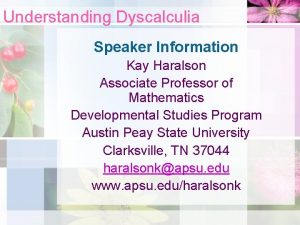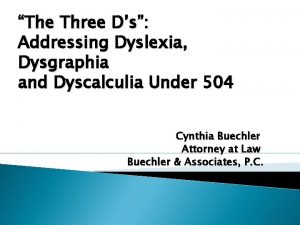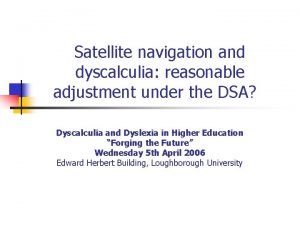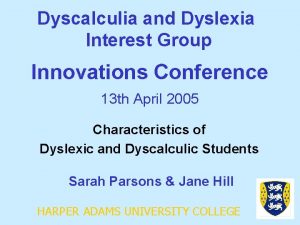DYSCALCULIA THE FAM 4 7 of people have
























































































































































- Slides: 152

DYSCALCULIA & THE FAM 4 -7 % of people have dyscalculia ISPA October 4, 2018 Linda Taylor, Ph. D Idaho School Psychologist

Agenda Brief neurology of mathematics Cognitive Processing & Math Deficit Dyscalculia FAM � Interventions & Teaching Strategies Math Anxiety � Math Anxiety Assessments Assessment of � Number sense � Cognitive deficits

Neuropsychology of Math (Feifer) q Language Skills (Temporal Lobes) q Early math skills tend to be verbally encoded. q Most Asian language have linguistic counting systems past ten (ten-one, ten-two, etc) whereas English deviates from base-10 system (Campbell & Xue, 2001) q Children with math disabilities frequently have delays in their language development. (Shalev et al, 2000) q Word problems offer an intricate relationship between language and mathematics. Terms such as all, some, neither, sum, etc. may be confusing

3 Basic Neural Codes to Format Numbers in the Brain (1) Verbal Code - numbers are encoded as sequences of words (twenty-four instead of 24). - Dehaene & Cohen, 1997 Left perisylvan region of temporal lobes. No need to understand quantitative concept. Main strategy used by younger children learning basic math facts (two plus two equals four) Critical for memorization of over-learned facts, such as multiplication facts (nine times nine equals eighty-one).

Parietal Lobe Frontal Lobe Temporal Lobe 5 Perisylvan Region Occipital Lobe

3 Basic Neural Codes to Format Numbers in the Brain (2) Procedural Code - numbers are encoded as fixed symbols representing a quantity of some sort, and sequenced in a particular order. ( 24 instead of twentyfour). - Von Aster, 2000 Bi-lateral occipital-temporal lobes. Critical for number identification skills. Circuitry involves the syntactical arrangement of numerals. Our internal number line. Critical in the execution of mathematical procedures for equations not committed to rote memory (e. g. subtraction with regrouping).

Frontal Lobe Parietal Lobe Temporal Lobe 7 Occipital-Temporal Region Occipital Lobe

3 Basic Neural Codes to Format Numbers in the Brain 8 (3) Magnitude Code - numbers are encoded as analog quantities. Allows for value judgements, such as “ 9” is bigger than “ 4”. (Chocon, et al, 1999) q Bi-lateral inferior parietal lobes. q q Allows for semantic understanding of math concepts and procedures. Allows for the evaluation of the plausibility of a response. q q q (9 X 4 = 94) Allows for the transcoding of more challenging tasks into palatable forms of operations. (15 percent of 80 becomes 10 percent of 80 plus half the value)

Frontal Lobe Parietal Lobe Temporal Lobe 9 Inferior Parietal Lobe Occipital Lobe

3 Basic Neural Codes: formatting numbers in the brain Triple Code Model (processing networks): Verbal Code � � � Automatic retrieval of over learned facts Left hemisphere Regions surrounding basal ganglia Deep in primitive region of entorthinal temporal cortex Insular temporal cortex (automatic over learned rote verbalizations) Visual-Verbal Code � Numbers represent fixed symbols 4 underlying concepts in order to learn � � Classification Ordering 1 -1 correspondence Conservation (volume quantities constant despite spatial differences) Left & right occipital-temporal regions Posterior tertiary zone Magnitude Code � � � Quantitative number comparisons Right hemisphere Inferior parietal region in tertiary zones of both hemispheres

Summary of Triple Code Model 11 MATH SKILL Addition Facts Hemisphere Multiplication Facts Hemisphere BRAIN REGION Perisylvan Region Left Regrouping Skills Long Division Temporal Bi-lateral Occipital- Estimation Skills Geometric Proofs Fractions Bi-lateral Inferior Parietal Lobe

Math Fluency (Russell, 1999) Efficiency (Working Memory) Flexibility (Executiv e Functionin g) Accuracy (Automati c Retrieval)

MATH FLUENCY (Russell, 1999) 13 Efficiency: Accuracy: A working knowledge Student does not get of number facts, combinations, bogged down into too many steps and other important number or lose track of logic or strategy. relationships. Flexibility: Knowledge of more than one approach to problem solve. Allows student to choose appropriate strategy and to double check work.

Qualities Needed Visual-motor Tasks � Copying geometric shapes, numbers or letters � Line up numbers � Reading numbers Memory � Encoding basic facts into LTM � Retrieving basic facts from LTM � Remembering steps for problem solving Visual-spatial Processing � Problems learning: Up-down, Near-far � Poor understanding of numbers � Difficulties with pictorial representations

Qualities Needed Auditory Processing � Problems following oral directions � Problems memorizing verbal information (x table, abbreviations) Language Processing � Math symbols represent numerical concepts � Needed for calculations, word problems, problem solving, computing Reasoning

Qualities Needed Attention � Need sustained attention to learn Executive Functioning � Includes attending, planning, self-monitoring, & decision making � Ability to regulate. Integrate, & coordinate several cognitive processes to work towards a goal Planning � Organize information � Understanding how to learn

Evaluation Areas Graphomotor � Numbers poorly formed, inaccurate � Problems copying geometric shapes & letters Memory � Retention & retrieval of number facts & tables � Forgets steps when doing a problem Visual-spatial Processing � Misalignment of numbers in columns � Confusion with carrying & borrowing � Misreading math signs � Problems with directions up-down, left-right, near-far-across

Evaluation Areas Auditory Processing (Ga, AUD Gsm) � Difficulty with oral drills Linguistic-verbal processing � Problems with: less than greater than more than Reasoning � Unreasonable solutions

Evaluation Areas Attention � Difficulty sustaining attention during instruction & directions Planning & Organizing � Difficulty problem solving Shift in Psychological Set � Applying the practical procedure

Cognitive Processing & Math Deficit Cognitive Area Crystalized Knowledge (Gc) Math Implication Visual-Spatial Processing (Gv) Difficulty with word problems Poor retrieval of over learned facts Difficulty with math terminology Difficulty lining up equations/numbers Poor magnitude comparisons Geometry Maps/Charts/Graphs

Cognitive Processing & Math Deficit Cognitive Area Nonverbal Fluid Reasoning(Gfnonverbal) Math Implication Verbal Fluid Reasoning(Gf-verbal) � WISC-V: Similarities & Comprehension Poor mental math skills Difficulty with estimation skills Poor pattern recognition skills Poor strategy formation skills Difficulty w/ word problems Limited inferential learning skills Poor understanding of Math terminology

Cognitive Processing & Math Deficit Cognitive Area Memory(Gsm) Math Implication Processing Speed(Gs) Tendency to forget steps of an algorithm in multiple step math problems Poor regrouping skills Difficulty with mental rotation tasks Poor mental math skills Difficulty with speeded skill drills Slower visual pattern recognition

Working Memory & Math Skill Working Memory Phonological Loop �Storage of auditory & verbal information �Left temporal lobe Mathematical Skill Write numbers from dictation Take lecture notes in math class Rapidly retrieve math facts stored in language dependent code Help understand word problems

Working Memory & Math Skill Working Memory Visual-Spatial Sketchpad �Holds visual, spatial & kinesthetic information in temporary storage using mental imagery �Housed along interior portion of Mathematical Skill Mental Math Problem Solving Helps line up place value when problem solving Magnitude representation Remembers sequence of steps or algorithm when problem solving Aids in geometry

Working Memory & Math Skill Working Memory Central Executive System � Central command post for modulating phonological loop & visual-spatial sketchpad systems � Allocates attention resources so multiple cognitive tasks can be executed � Primarily house in frontal lobes Mathematical Skill Inhibits distractions Modulates anxiety Regulates emotional distress Facilitates selective attention to math operational signs & key words in math word problems

Working Memory & Mathematics Working Memory System Symbolic Working Memory � � Related to executive capacity of working memory Each symbol (regardless of presentation format (auditory or visual) allows for verbal rehearsal strategies to keep information active through an inner articulatory loop while simultaneously resisting distractions Math Skill Mental math calculation Number line facility Sequence of math steps (algorithm) Facilitate math facts retrieval Numeric pattern recognition skill Cognitive representation of numbers Facilitates algebraic problem solving

Working Memory & Mathematics Working Memory System Math Skill Spatial Working Memory Referred to as visualspatial sketchpad of working memory � Modulated by frontal & parietal lobe reions � A variable in the development of spatial & magnitude representation skills � Alignment of numbers in columns Magnitude comparisons Estimation skills Elaspsed time Verbal spatial problem solving Facilitates geometric problem solving

Language/Math Delay Correlations Language Difficulties Overall Language Development Pervasive problems in expressive and receptive language Expressive language only deficits Math Difficulties Math disabilities Deficits in number reasoning & arithmetic problems Delays with overall counting skills (over 4)

Neuropsychology of Math Executive Functioning Skills: (frontal lobes) � Executive control mechanisms such as planning, self-monitoring, organizing, and allocating attention resources to effectively execute a goal directed task. � Executive functioning dictates “what to do when”, a critical process in solving word problems. � Executive functioning allows students to follow an algorithm when problem solving.

Neuropsychology of Math: EF Dorsal-lateral cortex - helps to organize a behavioral response to solve complex problem solving tasks. Orbitofrontal cortex - rich interconnections with limbic regions and helps modulate affective problem solving, judgement. Anterior cingulate cortex - allocates attention resources and modulates motivation.

Neuropsychology of Math: EF Executive Dysfunctio n Brain Region Selective Attention Anterior Cingulate Planning Skills Dorsallateral PFC Math Skill Poor attention to math operation signs Place value misaligned Impaired procedure/algorithm knowledge Poor estimation; Impaired selection of math process; Difficulty identifying key words in word problems

Neuropsychology of Math: EF Executive Dysfunctio n Brain Region Organization Skills Dorsallateral PFC Math Skill Inconsistent lining up or math equations; Frequent Erasures; Difficulty setting up problems Poor double checking of work; Self Monitoring Dorsallateral PFC Unaware of plausibility to a response; Cannot transcode 4 x 9 = (4 x 10)-4

Neuropsychology of Math: EF Executive Dysfunctio n Retrieval Fluency Brain Region Orbital Frontal PFC; Anterior Cingulate; Dorsal-lateral PFC Math Skill Slower retrieval of learned facts; Inconsistent accurate recall of learned facts

Dyscalculia: DSM-5 � Specific Learning Disorder A neurodevelopmental disorder of biological origin manifested in learning difficulty and problems in acquiring academic skills markedly below age level and manifested in the early school years, lasting for at least 6 months; not attributed to intellectual disabilities, developmental disorders, or neurological or motor disorders Specify if: 315. 00 With impairment in reading. 315. 2 With impairment in written expression 315. 1 With impairment in mathematics Specify current severity: Mild Moderate Severe

Definition Failure to achieve in mathematics commensurate with chronological age, normal intelligence, and adequate instruction. It is marked by difficulties with � � � visualization; visual-spatial perception, processing and discrimination; counting; pattern recognition; sequential memory; working-memory for numbers; retrieval of learned facts and procedures; directional confusion; quantitative processing speed; kinesthetic sequences; perception of time.

Neuropsychology of Math (Feifer) Math Disability (Dyscalculia)- refers to children with markedly poor skills at deploying basic computational processes used to solve equations (Haskell, 2000). These may include deficits with: (1) Poor language and verbal retrieval skills (2) Working memory skills (3) Executive functioning skills (4) Faulty visual-spatial skills

Terms for Dyscalculia Specific Learning Disability / Disorder in Mathematics (SLD-Math) Math Learning Disability (MLD) Developmental Dyscalculia (DD) Acalculia Gerstmann’s Syndrome (severe type of dyscalculia) Math Dyslexia Math Anxiety Numerical Impairment Number Agnosia Nonverbal Learning Disorder / Disability (NLD)

Geary & Hoard, 2005 Model Procedural Math Deficits � Difficulty following arithmetic procedures due to deficits in working memory and a poor conceptual understanding of numbers � One or more deficits in the ability to count, order, or sequence numbers and/or sequence mathematical procedures when problem solving. Deficits in left prefrontal cortex Visual-Spatial Deficits � Difficulties with spatial representation of numbers and limited magnitude representation skills � A disorder of the verbal representations of numbers and the inability to use language-based procedures to assist in arithmetic fact retrieval skills. Deficit in the posterior portion of the right parietal lobe

Geary & Hoard, 2005 Model Semantic Deficits � Poor ability to retrieve stored facts, usually due to long term memory and retrieval issues � Core deficit in both visual–spatial and conceptual components and an inability to decipher magnitude representations among numbers. Deficit in posterior region of the left hemisphere responsible for retrieving linguistic information

Types of Mathematical Disabilities Developmental Dyscalculia � Difficulty acquiring simple math operations despite adequate cognitive skills and exposure to education Acquired Dyscalculia � Difficulty retrieving stored mathematical facts from memory due to a cerebral insult

Developmental Dyscalculia Verbal Dyscalculia Semantic Dyscalculia (Left Persylvian) (bilateral inferior parietal lobes) Deficits Rapid Number ID Retrieval of stored facts Addition Multiplication Reading & Writing issues Magnitude representation Transcoding math operations Higher level proofs Estimation skills Conceptual understanding of math Preserved Number qualities Comparisons between numbers Understands basic concepts Visual spatial skills Preserved Reading & writing numbers Computational procedures Retrieval of overlearned facts Procedural Dyscalculia (Bilateral occipital temporal lobes) Visual-Spatial Dyscalculia (Right hemisphere white matter) Deficits Writing numbers from dictation Reading numbers aloud Math computational procedures Syntactical rules of problem solving Regrouping Division Procedures in subtraction Aligning a column of numbers Visual perception of numbers Spatial attributes (size, location, orientation, mental rotation) Magnitude comparisons Preserved Retrieval of overlearned facts Number comparisons Magnitude comparisons Preserved Retrieval of stored facts Reading Numbers Math algorithms Verbal Strategies

3 Subtypes of Developmental Dyscalculia Verbal Dyscalculia Subtype � � � Disorder of verbal representation of numbers Inability to use language based procedures to assist in arithmetic fact retrieval Difficulties counting and rapid number identification Deficit retrieving or storing over learned math facts Difficulties in reading and spelling Semantic Dyscalculia Subtype � � � Bilateral inferior parietal areas (hold semantic knowledge about numeric qualities allow for estimation skills) Left perisylvan region (storage of rote verbal sequences corresponding with math facts) Inability to understand magnitude representation among numbers (von Aster, 2000)

3 Subtypes of Developmental Dyscalculia Procedural Dyscalculia Subtype � � � � � Deficit processing and encoding numeric information Left & right inferior occipital-temporal region Frontal & subcortical loops interface with posterior mechanism for arithmetic procedures Difficulty recalling sequence of steps needed to perform multi-digit tasks Breakdown in Procedural Operations sequencing Difficulty transcoding numeric systems into meaningful language system Difficulty reading number aloud Difficulty writing numbers from dictation Difficulty starting in right hand column when doing subtraction Comorbid with ADHD (von Aster, 2000)

3 Subtypes of Math Disabilities 44 (1) Verbal Dyscalculia Subtype: Main deficit is the automatic retrieval of number facts which have been stored in a linguistic code. Multiplication and addition often impaired Poor at math fluency tests. Math algorithms often preserved. Often have learning disabilities in language arts as well. KEY CONSTRUCT: Verbal Retrieval Skills (RAN)

Verbal Dyscalculia Difficulty accurately retrieving overlearned math facts � Slower retrieving overlearned math facts Slower when rapidly naming & identifying numbers Confusion with math vocabulary terms Difficulty solving math word problems

Verbal Dyscalculia: Left Perisylvian Deficit Counting Rapid number identification Retrieval of stored facts Addition & multiplication facts May have coexisting reading & writing difficulties Preserved Numeric qualities Comparisons between numbers Understanding basic concepts Visual spatial skills

Procedural Dyscalculia Difficulty remembering the algorithm of sequenced set of procedures when problem solving Frequent errors in the execution of procedures Difficulty skip counting forwards & backwards Poor number line fluency Over reliance on immature counting procedures Poor ability to recognize math sequences Limited symbolic working memory

3 Subtypes of Math Disabilities 48 (2) Procedural Dyscalculia Subtype: A breakdown in comprehending the syntax rules in processing and encoding numeric information. Often associated with deficits in working memory. Difficulty writing numbers from dictation. Subtraction and division often impaired. Retrieval of math facts and magnitude comparisons often preserved. Key Constructs: Working Memory and Anxiety

Procedural Dyscalculia (Bilateral occipital temporal lobes) Deficit Writing numbers from dictation Reading number aloud Math computational procedures Syntactical rules of problem solving Deficits with division and regrouping procedures in subtraction Preserved Retrieval of over learned facts Comparisons between numbers Magnitude comparisons

Semantic Dyscalculia Subtype: 50 A breakdown in comprehending magnitude representations between numbers and understanding the spatial properties of numeric relations. Can be associated with lower IQ and faulty executive functioning skills. Difficulty evaluating the plausibility of a response � (e. g. 2 X 4 = 24) Inability to transcode math operations into a more palatable form � ( e. g. 9 X 4 is same as (4 X 10) - 4). Poor magnitude comparisons.

Semantic Dyscalculia (bilateral inferior parietal lobes) Deficit Magnitude representations Transcoding math operations Higher level math proofs Conceptual understanding of math Estimation skills Preserved Reading & writing numbers Computational procedures Retrieval of over learned facts

Visual-Spatial Dyscalculia Right hemisphere white matter disorder Gender biases (more females have it) Non verbal learning syndrome 2 subtypes � Right frontal dysexecutive syndrome impacts strategic development of novel concept formation � Right posterior visual-spatial-holistic problem solving capabilities � Combination of both Visual-spatial aspects of attention and memory processing disrupts the orthographic code which results in sloppy, misaligned, two dimensional paper-pencil math problem solving Comorbid with surface dyslexia due to breakdown in orthographic code

Visual-Spatial Dyscalculia (bilateral occipital parietal lobes) Deficit Aligning a column of numbers Visual perceptions of numbers Spatial attributes s (i. e. size, location, orientation, mental rotation) Magnitude comparisons Preserved Retrieval of stored facts Reading numbers Math algorithms Verbal strategies

Math Facts Error Analysis (Feifer, S. & De. Fina, P. , 2005, p. 65) Math Fact � 6 + 6 = 10 Operand � 6 - 5 = 11 Algorithm � 123 -87 44 Place Value � . 70 +. 75 . 145 Word Problem Difficulties Verbal retrieval error Procedural error due primarily to poor attention & executive function Procedural error due to poor working memory Verbal dysfunction & poor saliency determination

Feifer Assessment of Mathematics (FAM)

FAM (https: //www. parinc. com/Products/Pkey/109) Age range: 5 - 21 years Time: � PK: 35 minutes � K-Grade 2: 50 minutes � Grade 3+: 60 minutes � Screening Form: 15 minutes Qualification level: S Price: � Comprehensive Kit: $502 � FAR & FAM: $891

FAM Indices Procedural Index (PI) Verbal Index (VI) Semantic Index (SI) FAM Total Index (TI) FAM Screening Index

Procedural Index (PI) Number Forward Count Backward Forward Count Numeric Capacity Sequences (deductive reasoning) The Procedural Index represents deficits in the ability to count, order and sequence numbers or mathematical procedures. It measures auditory memory for numbers, sequencing and deductive reasoning. Weaknesses in symbolic working memory (Numeric Capacity, AUD Gsm) can result in a variety of math difficulties such as losing one’s place when problem solving, poor mental math skills, and forgetting the series of steps (or algorithm) needed to solve more complex equations. This could be exacerbated by math anxiety. In addition, the Sequences subtest requires executive functioning skills and deductive reasoning (top down approach) to identify the underlying rule that holds the information together.

Procedural Index (PI) Number Capacity (average) > Number Count suggests that struggles more with mental manipulation and sequencing aspects of number processing. Forward Number Count > Backward Number Count suggests limitations in working memory and over reliance on fingers when skip counting, over rely on the number line, or struggle with most types of mental math. Backward Number Count> Forward Number Count suggests poor automaticity with skip counting despite an adequate understanding of arithmetic concepts. Barbati may have careless errors when problem solving. � Interventions should be geared towards teaching base 10 counting strategies and helping Barbati develop number line fluency, practice skip counting and use 100 charts to better comprehend patterns and relationships among numerals.

Procedural Index (PI) Number Count > Sequences � suggests Barbati has good auditory working memory and knowledge of arithmetic procedures but struggles with the executive functioning component of math due to poor deductive reasoning skills. Sequences > Number Count � suggests Barbati has good deductive reasoning and pattern recognition skills but struggles with auditory working memory of numbers needed to execute mathematical tasks without a visual

Procedural Dyscalculia: Instructional Strategies Tens frame chart or Number line on desk Practice skip counting from various points on the number line Play math games to develop number line fluency skill � (e. g. , Chip’s Game from the book “Playing The Name of the Game”) with Math: Teach to concept development and reduce the amount of ‘busy work’ Teach multiple methods of problem solving so s/he can select the one that s/he understands

Procedural Dyscalculia: Instructional Strategies Help with Math Equations with multiple steps Develop a mnemonic code to help remember order of steps � Eg. , to remember the steps for long division Divide, Multiply, Subtract, Bring down = Dead Monkeys Smell Bad Reduce Math Anxiety Untimed tests Redo incorrect problems Take tests in different location Poor Attention Color code math operation signs Use graph paper to complete work

Procedural Dyscalculia: Interventions 63 Freedom from anxiety in class setting. � Allow extra time for assignments and eliminate fluency drills. Color code math operational signs and pair each with pictorial cue. Talk aloud all regrouping strategies. Use graph paper to line up equations. “Touch math” to teach basic facts. Attach number-line to desk and provide as many manipulatives as possible when problem solving. Teach skip-counting to learn multiplication facts.

PI: Working Memory Strategies Read math problems out loud (or under your breath) Create acronyms to learn sequence of steps � Example: to remember the order of operations use Create a checklist with visual cues Use scratch paper (avoid mental math) See all information while problem solving � (have all information on one page or see both pages on computer screen) PEDMAS = Please Excuse My Dear Aunt Sally = Parentheses, Exponents, Multiplication, Division, Addition, Subtraction Avoid having to use multiple handouts, flip through multiple text book pages or switch computer screens when doing homework Use 100’s chart (not calculator) for assistance while learning math facts Create visual cue card (put the word acute inside the acute angle)

Procedural Dyscalculia Programs On Cloud Nine (Lindamood Bell) � Helps develop visual imagery when working with numbers and equations Do the Math � Helps develop number operations

Verbal Index (VI) Rapid Number Naming (automatic number ID skills) Addition Fluency (automatic recall of overlearned facts) Subtraction Fluency Multiplication Fluency Division Fluency Linguistic Math Concepts (define & reason w/ math vocabulary) Measures one’s ability to quickly retrieve information from long-term memory (Rapid Number Naming). Lower scores on the Verbal Index suggests deficit is the automatic retrieval of symbolic information stored in a linguistic fashion. The verbal subtype of dyscalculia often hinders one’s ability to use language based procedures in arithmetic fact retrieval of over learned skills. However, it does NOT hinder one’s ability to

Verbal Index (VI): Subtest Analysis Rapid Number Naming > Math Fluency represents a typical LD due to poor retrieval skills of math facts only (problems with angular gyrus). Names of numbers are retained (language) but the ability to memorize and retrieve longer chains of numeric information stored in a math sentence is problematic. � Flash cards tend to reinforce rote memorization of facts in the linguistic code without having any quantitative value. This creates a surface learner who can regurgitate acts but does not have an understanding of the symbols to be able to recall them over time. � Educators should focus on reinforcing the nonsymbolic elements of numbers in order force students to use more spatial brain regions instead of over relying on linguistic

Verbal Index (VI): Subtest Analysis Addition & Multiplication > Subtraction & Division �Neurological profile Addition > Subtraction>Multiplication > Division �Developmental profile

Verbal Index (VI): Subtest Analysis Math Fluency > Linguistic Math Concepts � Can rapidly retrieve information from long term memory but has a deficit in understanding math vocabulary and terminology. This suggests that Barbati may have memorized math facts in an efficient manner but has difficulty generalizing and applying mathematical thinking to real world problems. Because s/he has a lack of conceptual understanding of mathematical principles. � Interventions may include writing or stating a verbal story from a math sentence in order to develop a better contextual understanding of numbers. Linguistic Math Concepts > Math Fluency � Understands math vocabulary and terminology but has a deficit in rapidly retrieving information from long term memory

Verbal Index (VI): Subtest Analysis Linguistic Math Concepts > Math Fluency �Understands math vocabulary and terminology but has a deficit in rapidly retrieving information from long term memory �Has a good theoretical and conceptual understanding of math �Typical of students with a mathematical learning disability

Verbal Dyscalculia: Testing Profile RAN – low Math Fluency - low Difficulties with Word Problems � Math Problem Solving - low Poor Reading Poor Spelling

Verbal Dyscalculia Instructional Strategies Automatic Math Fact Retrieval Strategies � Math Fact Family Chart (create & keep close by) � Use Dot Array Cards for addition & multiplication facts � Flash card rings � Practice writing & verbalizing math facts using large physical movements � Paper Plate Games � Practice difficult facts by rolling a pair of dice � Math War � Play Egg Carton Shake up (practice math facts) � Family Math Facts practice � Use mnemonics for easy to learn rules � Multiplication Go-Fish Game

Verbal Dyscalculia: Instructional Strategies Math Vocabulary Strategies � Create a Concept Web to represent different math vocabulary terms � Highlight or draw a box around key words & phrases in math assignments � Label the problem � Create a chart of common key words used in word problems � Tell a verbal story from a math equation � Create a math dictionary notebook

Verbal Dyscalculia: Interventions (Wright, Martland, & Stafford, 2000) q q Distinguish between reciting number words, and counting q (words correspond to number concept). Develop a forward number word sequence (FNWS) and backward number word sequence (BNWS) to ten, twenty, and thirty without counting back. q Helps develop an automatic retrieval skills. Develop a base-ten counting strategy whereby the child can perform addition and subtraction tasks involving tens and ones. Reinforce the language of math by re-teaching

Semantic Index (SI) Spatial Memory (Gv + Gsm) Equation Building (Executive Functioning) Perceptual Estimation (Gv) Number Comparison (Gs) Knowledge: (semantic understanding of # relationships and # sense) � Addition Knowledge � Subtraction Knowledge � Multiplication Knowledge

Semantic Index (SI) includes deficits with non-symbolic representations of math such as difficulty with estimation skills, aligning numbers in columns, magnitude representation and visual pattern recognition skills and symbolic representations of numbers (poor number sense and poor conceptual understanding of basic mathematical principles). The visual-spatial component of the Semantic Index tends to affect non-symbolic representation of math including estimation, aligning numbers in columns, magnitude representation, and pattern recognition. The conceptual component (executive functioning skills) of the Semantic Index refers to an inability to develop number sense and tends to affect symbolic representation of numbers. The Equation Building subtest measures quantitative knowledge and executive functioning skills.

SI Subtest Analysis Perceptual Estimation > Number Comparison � More adept at using visually based strategies to determine math representation. Perceptual Estimation < Number Comparison � More adept at using symbolic information to determine magnitude representation Math Knowledge Comparisons � Use inverse operations to help understand the weaker area

SI Subtest Analysis Equation Building > Math Knowledge � Have stronger quantitative reasoning and executive functioning skills for mathematics. Have a stronger conceptual understanding of mat due to a strong nonsymbolic understanding of space and time but lack core number sense to execute math calculation skills. Equation Building < Math Knowledge � Have good semantic understanding of numbers due to good symbolic reasoning skills but may have difficulty generalizing their number sense to apply to math problems in a real world context.

79 Semantic Dyscalculia: Interventions Reinforce basic pattern recognition skills by sorting objects by size and shape. Have students explain their strategies when problem solving to expand problem solving options. Teach estimation skills to allow for effective previewing of response. Have students write a math sentence from a verbal sentence. Construct incorrect answers to equations and have students discriminate correct vs. incorrect responses. Incorporate money and measurement strategies to add relevance. Use “baseball” examples as well.

Semantic Recommendations Avoid using flash cards & rote repetitive exercises to a new concept prior to task mastery Present information in context, especially relating it to his/her background knowledge, experience and interests Play math games to increase general number sense � Playing with Math � Name of the Game

Semantic Recommendations Facilitate Multiplication & Division (help develop number sense) Manipulatives/Hands on Instruction � Dice, dominoes, Unifix cubes Number line on desk Skip counting Tap with fingers when counting Teach math vocabulary Use music to overlearn facts Play math games at home Emphasize teaching estimation skills with magnitude representations to force student to think in pictures Use mnemonics to over learn math facts Incorporate an area of passion in all lessons � (i. e. , Minecraft, train on time fractions, etc. )

Semantic Dyscalculia Strategies Visual Spatial Strategies � Turn notebook sideways � Use graph paper � Avoid crowding � Enlarge charts & graphs � Use a ruler to draw shapes & diagrams � Consider a vertical number line � Use manipulatives � Draw a T when solving equations � Create a pocket chart from a file folder to learn place value � Color code and number each step when problem solving with fractions and long division

Semantic Recommendations Targeted Math Intervention Programs � Hot Math (helps 3 rd graders transfer solutions strategies to word problems) � Number Words (enhances core number sense) � Dreambox Learning (develops deeper conceptual understanding of multiplication and division)

Semantic Index (sample write up) Lower scores in this index often suggest limitations with quantitative reasoning and number sense and also difficulty applying mathematical skills to solve reals world problems. A relative weakness was noted in with visual spatial memory. Specific weaknesses with visual-spatial memory can hinder estimation and magnitude representation skills and suggests s/he may be memorizing rote symbols (digits) void of magnitude representation.

Semantic Index (Sample write up) Student presented with a profile of a student with a math learning disability consistent with Semantic Dyscalculia. There were noted processing deficits with visual-spatial memory, perceptual estimation tasks, as well as with quantitative reasoning and numeric pattern recognition skills. S/he appears to memorizing math facts void of meaning due to a stronger symbolic working memory instead of developing a conceptual understanding of numerals.

Semantic Index (sample write up) Student’s limited visual-spatial memory also seemed to hinder his/her performance with perceptual estimation types of tasks. Furthermore, student also struggles with his/her conceptual understanding of basic addition, subtraction, multiplication and division (in Verbal Index). In fact, s/he performed much better on most fluency measures which suggest that s/he is most likely memorizing basic facts instead of conceptual knowledge of numerals build around core number sense. Lastly s/he had significant difficulty determining how to set up math equations when presented with a word problem Lower scores in this area suggest difficulty

FAM Cross Index Comparisons: Rapid Number Naming (verbal) > Number Comparison (semantic) � Have good number (symbolic) identification skills but lacks deeper understanding of the nonsymbolic value or magnitude that numbers represent. (too much rote (verbal) memorization of facts without understanding to quantity and magnitude of numbers). Rapid Number Naming (verbal) < Number Comparison (semantic) � May be due to an underlying language based learning disability that is hindering rapid naming skills or non neuro -psychological factors such as anxiety, inconsistent task motivation, etc.

FAM Cross Index Comparisons: Linguistic Math (verbal) > Equation Building (semantic) (check Verbal Index > Semantic Index) � The student understands the language of mathematics (Linguistic Math Concepts) but has difficulty with the symbolic understanding of mathematics (Equation Building). This suggests one has the verbal ability to explain the problem but has difficulty formulating a mathematical sentence in symbolic form. This requires numeric coding of verbal information, quantitative reasoning and executive functioning skills to cue the mathematical processing centers in the brain to identify the sequential order of

FAM Cross Index Comparisons (cont. ) Linguistic Math (verbal) > Equation Building (semantic) (check Verbal Index > Semantic Index) This response pattern suggests a core deficits in executive functioning skills pertaining to math symbolic information. This response pattern suggests that the student understands math vocabulary terms but may struggle with the logical arrangements of symbolic codes when engaged in quantitative reasoning. � Specific interventions should be geared towards encouraging students to learn math context more relevant to their background, knowledge and experiences to develop a greater understanding of a particular concepts. The use of manipulatives (e. g. , dice, dominoes, Unifix cubes) can help to strengthen magnitude representations before learning mathematical shorthand or symbolic information. Using a Bar graph similar to the Singapore Math Approach (Hoven & Garelick, 2007) with word problems can be an intermediary �

FAM Cross Index Comparisons: Linguistic Math (verbal) < Equation Building (semantic) � Suggests poor expressive vocabulary or limited conceptual understanding of math concepts. Often color coding words in math sentences, teaching math vocabulary terminology separately or having the student write a verbal sentence for math equation are helpful.

FAM Cross Index Comparisons: Numeric Capacity (procedural) > Spatial Memory (semantic) � Auditory memory for numbers is significantly better than visual-spatial memory. Weaknesses in spatial memory affect estimation skills, align problems into columns and disrupts overall magnitude representations. � Specific interventions include using graph paper, providing visual cues and use paper/pencil problem solving to mediate visual-spatial working memory weaknesses.

FAM Cross Index Comparisons: Numeric Capacity (procedural) < Spatial Memory (semantic) � Visual-spatial memory is significantly better than auditory memory for numbers. Therefore, barbate may struggle mental math skills, may forget algorithms on multistep equations and/or difficulty sequencing numeric information � Anxiety can be a mitigating factor � Interventions include teaching efficient strategies for problem solving, use mnemonics, providing number lines or tens frame chart to assist with ordering and sequencing information.

FAM Cross Index Comparisons: Number Count (procedural > Math Fluency (verbal) � Suggests Barbati has a good conceptual understanding of number relationships but lacks the ability to use memory strategies to automatically retrieve stored facts from LTM. � This is a typical response pattern of students with language-based learning disability. � Check to make sure math anxiety is not impeding the automaticity of math fact retrieval skills Number Count (procedural < Math Fluency (verbal) � This response pattern is typical of students who have memorized math facts in a rote manner but has poor automaticity with skip counting and may over rely on

FAM Cross Index Comparisons: Sequences (procedural) > Perceptual Estimation (semantic) � May have better top-down executive functioning skills, including strong deductive reasoning skills. May do well with symbolic reasoning math course (i. e. , algebra). Sequences (procedural) < Perceptual Estimation (semantic) � May have better “bottom’s up” processing for magnitude representation

FAM Cross Index Comparisons: Math Fluency (verbal) > Math Knowledge (semantic) � Typical response pattern of students who have who have memorized math facts in a rote manner and lack a deeper understanding of number sense. This could also be due to poor instruction. Math Fluency (verbal) < Math Knowledge (semantic) � Have a good appreciation of number sense, but lack the ability to shift to memory based processing and the automatic retrieval of information stored in a language based code. � Anxiety may also impede the automatic retrieval of math facts.

FAM Screener Verbal Index: � Linguistic Math Concepts (LMC) Procedural Index � Sequences (SEQ) Semantic Index � Number Comparison (NCO) Best predictors of math skill in each type of dyscalculia

Math Calculations Idaho SLD WJ-IV Math Calculation Skills Cluster WIAT-III: Numeric Operations KTEA-3: Math Computation FAM Forward Number Count Backward Number Count Addition Knowledge (60 sec) Subtraction Knowledge Multiplication Knowledge Division Knowledge

Math Fluency Idaho SLD WJ-IV Math facts Fluency WIAT-III Math Fluency � Addition � Subtraction � Multiplication FAM Addition Fluency Subtraction Fluency Multiplication Fluency Division Fluency

Math Problem Solving Idaho SLD WJ-IV problem Solving Cluster WIAT-III Math Problem Solving FAM Equation Building Linguistic Math Concepts

Memory (Gsm) FAM WISC-V � WMI AWMI VWMI WJ-IV COG � Working Memory Numeric Capacity Spatial Memory

FAM Critique Pros Neurologically based Good interventions/strategies In depth information on student’s deficit Administration goes quickly and less stressful for student as many math subtests are only 30 seconds Cons No statistical cluster score for SLD area Advanced interpretations � OK for teachers to interpret? No index scores for Idaho SLD areas Expensive Hand Scored

Math Apps & Instructional Websites Math is Fun � Resources, targeted worksheets, games, exercises, lesson ideas Illuminations � Quality standards based resource � Interactive tools for students & instructional supports for teachers Math Crunch � Fast way to get math help on your phone Cool Math � Explanations for higher level math (algebra & calculus) Coolmath 4 kids � For children under 12

Delivering Math Instruction (2008 Meta analysis) Small group instruction Address skills necessary for the Unit Be explicit & systematic Use graphic representations Balanced Curriculum

Pedagogy Suggestions Metacognitive training � Teach proper decision making skills � Algorithmic procedures � Profoundly influences math achievement (p. 66)

Pedagogy Suggestions Use graph paper for students who have difficulty organizing ideas on paper. Work on finding different ways to approach math facts; i. e. , instead of just memorizing the multiplication tables, explain that 8 x 2 = 16, so if 16 is doubled, 8 x 4 must = 32. Practice estimating as a way to begin solving math problems. Introduce new skills beginning with concrete examples and later moving to more abstract applications. For language difficulties, explain ideas and problems clearly and encourage students to ask questions as they work. Provide a place to work with few distractions and have pencils, erasers and other tools on hand as needed.

Strategies to Facilitate Working Memory in Classroom (p. 67) Teach multiple ways to problem solve Avoid speed competitions with students Link problem solving with passion Set algorithmic procedures to song Encourage visual cues

General Dyscalculia Interventions Freedom from anxiety in class setting Mnemonic strategies Talk aloud Use graph paper Student directive algorithms � Teach multiple methods & allow student decide which to use Vertical number lines Manipulatives

General Dyscalculia Interventions Manipulatives Estimation games Teach skip counting by drumming Teach base-10 counting strategies Teach patterns and relationships Provide worksheets with answers Construct an equation from verbal sentences Reinforce the language of mathematics Apply math to real life � (batting averages, recipe, stocks, interest)

Common Interventions Graphomotor � Tape record notes � Use keyboard � Oral-input software for composing Memory � Use multi-sensory strategies w/repetition � Use graphic organizers � Tape record lectures Visual-spatial Processing � Precise & clear verbal instructions � Verbal repetition � Use highlighting for visual a focus (operating signs)

Common Interventions Auditory Processing � Slow down pace of instruction � Use pictures & other visuals � Focus on non-verbal cues Linguistic-verbal Processing Slow down pace of instruction � Ask student to verbalize what they are doing Reasoning � Use graphic organizers to show relationships � Teach generalization & application across contexts � Create routines with frequent breaks

Common Interventions Attention � Develop routines with frequent breaks � Create cue sheets & mnemonics Planning & Organization � Create flow charts/graphs/cognitive webs � Highlight & color-code important information

Attention Strategies Circle math operation signs Write a small number above each step in the directions Write down all formulas before solving a problem Highlight, circle, or color code math operational signs Talk aloud when problem solving Divide longer assignments into parts Double check work by tapping the eraser on each number

Strategies for Addition Estimation: is the answer reasonable? Use graph paper to set up problems Apply knowledge to place value Use manipulatives (base 10 blocks) to represent place value Use number lines & 100 charts for skip counting Recognize the patterns in numbers Use mental math strategies

Subtraction Strategies Use base 10 blocks to represent values Use place value mats Use tens frame Draw pictorial representations

Multiplication Strategies Estimation: Is the product reasonable? Use place value strategies Break the problem apart � 26 x 13 = (26 x 10) + (26 x 3) � 16 x 4 = (10 x 4) + (6 x 4) Know basic facts Use tally marks to group numbers

Strategies for Division Skip counting to help find equal groups Know fact families Drawing a pictorial representation Explore using manipulatives Place value format Scaffolding (Feifer, p. 149)

Interventions for Lower Cognitive Skills 117 q Manipulatives and hands-on type of instruction. q Number-line situated on student’s desk. q Drill and repetition. q Focus on algorithm. q Skip counting. q Tap a drum beat when counting. q Check for plausibility of response. q Have student tell a number story to insure comprehension. q Teach “math vocabulary” q Utilize music, especially rap, to over-learn facts. q Incorporate an area of passion in all lessons (e. g. baseball statistics, Yu. Gi-Oh life points, NASCAR standings, etc. )

Interventions for Poor Visual-Spatial Skills 118 q q q Turn a visual problem into a verbal problem. Have students talk their way through a problem. Use graph paper to help line up equations. Make sure problems are written vertically as opposed to horizontally. Attach number-line to desk. Greater emphasis teaching estimation skills and magnitude representations.

119 Interventions for Lower Working Memory Number-line situated on student’s desk. q Use a calculator. q Reduce anxiety in the classroom. q Increase number sense through games such as dice, domino’s, cards, etc. . q Encourage paper and pencil use while calculating equations. q Use mnemonic techniques to teach math algorithm’s and sequential steps to problem solving. q

Assessment: Number Sense Screener Proven to be highly predictive of math disability in kindergarten and first grade Developed by Nancy Jordan, Ed. D, University of Delaware, "Number Sense Screener, " published by Brookes Publishing

Executive Functioning & Math Deficits: NEPSY/D-KEFS Executive Functioning Area Tower Auditory Attention Response Set Math Implication Planning, inhibition, self -monitoring Cognitive flexibility, sustained attention Visual Attention Design Fluency Visual attention to math symbols, processing speed Nonverbal strategy formation skills, planning, comparisons

Executive Functioning & Math Deficits: NEPSY/D-KEFS Executive Functioning Area Math Implication Phonological Processing Phonological awareness, syllable segmentation contribute to accurate reading of word problems Speeded Naming Visual/verbal retrieval skills key for over learning math facts Comprehension of Instructions Auditory working memory, receptive language skills

Sensori-Motor Functioning & Math Deficits: NEPSY/D-KEFS Sensori-Motor Functioning Area Math Implication Fingertip tapping Imitating Hand Positions Visuomotor Precision Motor speed and dexterity Visual perception, praxis, spatial awareness Visual-motor integration, graphomotor coordination, manipulating a pencil

Visual-Spatial Functioning & Math Deficits: NEPSY Visual-Spatial Functioning Area Math Implication Design Copy Arrows Visuomotor integration visual perception of abstract shapes Spatial orientation Lining up math equations

Memory & Math Deficits: NEPSY Visual-Spatial Functioning Area Math Implication Memory for Faces Memory for Names Narrative Memory Visual perception of details and memory for nonverbal information Visual/Verbal retrieval skills Auditory working memory Sequencing

Anxiety & Math

127 The Anxious Brain and Mathematics Math Anxiety + Time Constraints = Poor Performance Males have stronger SAT math scores than females (SAT mean boys = 595 vs SAT mean girls = 554) Girls reported more anxiety and less self-confidence on visual spatial problem solving tasks (Casey, 1997)

128 The Anxious Brain and Mathematics SUMMARY: MATH ANXIETY (Casey, 1997): Math anxiety alone not solely responsible for differences between boys and girls. Students with cognitive flexibility to use either a verbal or a visual-spatial strategy when solving a math problem are inherently less likely to become anxious than students with a singular methodology. Anxiety itself may serve as a double-edged sword in that the more anxious we become, the less cognitive flexibility we have to use alternative problem solving strategies.

129 The Anxious Brain and Mathematics Working Memory and Anxiety: Students with elevated levels of math anxiety perform more poorly than students with lower math anxiety on all levels of mathematical problem solving (Kellogg et al, 1999). Central executive system (which functions to inhibit negative distracters), is often rendered useless when anxious (Anterior Cingulate). � This paves the way for worrisome and negative thoughts which overburden the system (Hopko et

5 Ways to Reduce Math Anxiety 130 Teach multiple ways to problem solving : � Students who utilize both visual/spatial and verbal strategies outperform students who over-rely on just a singular methodology Avoid skill drills: � Speed and competition creates anxiety. Obtain fluency without classroom competitions. Link problem solving with passion: � Attach personal meaning to the harshness of cold problem solving. Baseball batting averages or Yu-Gi. Oh life points are a fun way to learn math operations.

5 Ways to Reduce Math Anxiety 131 Set algorithmic procedures to a song: � Lower anxiety leads to better working memory and better working memory lowers anxiety. Set math operational steps to a song or rap, as verbal strategies often serve as a memory enhancer. Encourage visual cues: � Students who take the time and effort to jot down equations on paper as opposed to working out equations in their head, put less stress on working memory systems.

Math Anxiety Strategies Write anxious thoughts on paper before beginning a test Visualized where you studied and completed practice problems for the test Learn mindfulness techniques when breathing Survey the entire test prior to beginning Positive Self talk Smile Have a back up plan Minimize unit test coverage

Math Anxiety Interventions Use paper and pencil �Scratch paper with steps to solve problem Eliminate timed tests Use mnemonic techniques Use manipulatives Use a calculator judiciously �Use to minimize rote calculations

Math Anxiety Interventions Reduce classroom anxiety �Positive classroom environment �Encourage risk taking, asking questions, & personal growth Less emphasis on high stakes tests Allow a take-over Content & meaning Student directed algorithms

Math Anxiety Assessments (Young) Mathematics Anxiety Scale for Young Children �(12 questions) Children's Anxiety in Math Scale Child Math Anxiety Questionnaire CMAQ-R Math Anxiety Questionnaire – Scales C & D

Abbreviated Math Anxiety Rating Scale (5 point scale) Having to use the tables in the back of a math book Thinking about an upcoming math test the day before Watching a teacher work a difficulty equation on the board Taking an examination n math Being given a homework assignment in many difficult problems due the next day Listening to a lecture in math class Listening to another student explain a math problem being given a “Pop” quiz in Math class Starting a new chapter in a math book

References D’Amato, Fletcher-Janzen, & Reynolds (2005). Handbook of School Neuropsychology. John Wiley & sons: Hoboken, NJ. Feifer, S. & De. Fina, P. (2005). The Neuropsychology of Mathematics: Diagnosis and intervention. School Neuropsych Press, LLC: Middletown, MD

Resources Math Learning Disability Resource � http: //www. dyscalculia. org/ Designing Mathematics Instruction: A Direct Instruction Approach � excellent book for assessing & teaching math

Feifer Assessment of Reading FAR

Reading (Receptive/Fluent Aphasia) Developmental Dyslexia Dysphonetic Dyslexia Surface Dyslexia Mixed Dyslexia (Left Hemisphere Disorder) (Right Hemisphere Disorder) (Left & Right Hemisphere Disorder)

FAR Phonological Index Fluency Index Mixed Index Comprehension Index FAR Total Index

Phonological Index Phonemic Awareness Nonsense Word Decoding Isolated Word Reading Oral Reading Fluency Positioning Sounds

Fluency Index RAN Verbal Fluency Visual Perception Irregular Word Reading Fluency Orthographic Processing

Mixed Index (Double Deficit) Phonological Index Fluency Index

Comprehension Index Semantic Concepts �Synonyms & antonyms Word Recall Morphological Processing Silent Reading Fluency: Comprehension �Silent Reading Fluency: Rate

Rapid Automatic Naming (Glr-NA) Idaho SLD WISC-V Rapid Naming Index CTOPP-2 Rapid Symbolic Naming Composite WJ-IV COG Retrieval Fluency subtest FAR Rapid Automatic Naming subtest

Phonological Awareness/Coding (Ga. PC) Idaho SLD WJ-IV ACH Phoneme/Graphem e Cluster � Word Attack � Spelling of Sounds WIAT-III Basic Reading Skills subtest FAR Phonemic Awareness Positioning Sounds

Basic Reading Skills Idaho SLD WJ-IV ACH Basic Reading Skills Cluster � Letter Word ID � Word Attack WIAT-III � Word Reading � Pseudoword Decoding FAR Nonsense Word Decoding Isolated Word Reading

Reading Fluency Idaho SLD WJ-IV ACH Reading Fluency Cluster WIAT-III Reading Fluency FAR � Silent Reading Fluency: Rate � Oral Reading Fluency � Typical Reading Fluency Format GORT-5 Reading Fluency � Typical Reading Fluency Format Typical Reading Fluency Format: Single Word Reading � Verbal Fluency

Reading Comprehension Idaho SLD WJ-IV ACH Reading Comprehension Cluster WIAT-III Reading Comprehension � � � Typical Reading Comprehension Format Text available for reference GORT-5 Reading Comrehension � FAR Typical Reading Comprehension Format Text not available for reference Silent Reading Comprehension subtest � Text not available for reference Semantic Concepts (synonyms & antonyms)

FAR Critique Pros Good correlations to appropriate reading intervention Neurologically based In depth information on where deficits lie Cons Expensive Advanced interpretations � OK for teachers to interpret? Often non-unitary Index Scores Need to use CHC model to get an SLD Index score Only 1 true reading Comprehension subtest

Thank you! Linda Taylor, Ph. D linda. taylor@vallivue. org Vallivue School District Caldwell, ID Complete FAR presentation will be presented at the Boise Professional Development Class beginning January 2019
 Dyscalculi
Dyscalculi Dyscalculia
Dyscalculia Dyscalculia simulation activity
Dyscalculia simulation activity Dyscalculi
Dyscalculi Math fam
Math fam 6 rectangular faces 12 edges 8 vertices
6 rectangular faces 12 edges 8 vertices Ariesweb
Ariesweb Fam link
Fam link Leccin
Leccin Ouh fam
Ouh fam Ariesweb csu
Ariesweb csu Fam link
Fam link Gao financial audit manual
Gao financial audit manual Pmu fam items
Pmu fam items The possessive adjectives modify nouns.
The possessive adjectives modify nouns. Sbu/noforn
Sbu/noforn Gabriele wienhausen
Gabriele wienhausen Indirect object pronouns (continued)
Indirect object pronouns (continued) Polihedral
Polihedral The fam fite
The fam fite Think family ni
Think family ni![(you [fam.] dropped) las pastillas. (you [fam.] dropped) las pastillas.](data:image/svg+xml,%3Csvg%20xmlns=%22http://www.w3.org/2000/svg%22%20viewBox=%220%200%20200%20200%22%3E%3C/svg%3E) (you [fam.] dropped) las pastillas.
(you [fam.] dropped) las pastillas. Fam it
Fam it Quá trình desamine hóa có thể tạo ra
Quá trình desamine hóa có thể tạo ra Công của trọng lực
Công của trọng lực Thế nào là mạng điện lắp đặt kiểu nổi
Thế nào là mạng điện lắp đặt kiểu nổi Hình ảnh bộ gõ cơ thể búng tay
Hình ảnh bộ gõ cơ thể búng tay Các loại đột biến cấu trúc nhiễm sắc thể
Các loại đột biến cấu trúc nhiễm sắc thể Vẽ hình chiếu đứng bằng cạnh của vật thể
Vẽ hình chiếu đứng bằng cạnh của vật thể Nguyên nhân của sự mỏi cơ sinh 8
Nguyên nhân của sự mỏi cơ sinh 8 Phản ứng thế ankan
Phản ứng thế ankan Voi kéo gỗ như thế nào
Voi kéo gỗ như thế nào Các môn thể thao bắt đầu bằng tiếng nhảy
Các môn thể thao bắt đầu bằng tiếng nhảy Thiếu nhi thế giới liên hoan
Thiếu nhi thế giới liên hoan Khi nào hổ con có thể sống độc lập
Khi nào hổ con có thể sống độc lập điện thế nghỉ
điện thế nghỉ Một số thể thơ truyền thống
Một số thể thơ truyền thống Trời xanh đây là của chúng ta thể thơ
Trời xanh đây là của chúng ta thể thơ Slidetodoc
Slidetodoc Bảng số nguyên tố
Bảng số nguyên tố Tia chieu sa te
Tia chieu sa te Các châu lục và đại dương trên thế giới
Các châu lục và đại dương trên thế giới Glasgow thang điểm
Glasgow thang điểm Thế nào là hệ số cao nhất
Thế nào là hệ số cao nhất Hệ hô hấp
Hệ hô hấp ưu thế lai là gì
ưu thế lai là gì Tư thế ngồi viết
Tư thế ngồi viết Cái miệng nó xinh thế chỉ nói điều hay thôi
Cái miệng nó xinh thế chỉ nói điều hay thôi đặc điểm cơ thể của người tối cổ
đặc điểm cơ thể của người tối cổ Mật thư tọa độ 5x5
Mật thư tọa độ 5x5 Bổ thể
Bổ thể Tư thế ngồi viết
Tư thế ngồi viết Thẻ vin
Thẻ vin Thơ thất ngôn tứ tuyệt đường luật
Thơ thất ngôn tứ tuyệt đường luật Chúa yêu trần thế alleluia
Chúa yêu trần thế alleluia Các châu lục và đại dương trên thế giới
Các châu lục và đại dương trên thế giới Từ ngữ thể hiện lòng nhân hậu
Từ ngữ thể hiện lòng nhân hậu Diễn thế sinh thái là
Diễn thế sinh thái là Vẽ hình chiếu vuông góc của vật thể sau
Vẽ hình chiếu vuông góc của vật thể sau Thế nào là giọng cùng tên? *
Thế nào là giọng cùng tên? * 101012 bằng
101012 bằng Tỉ lệ cơ thể trẻ em
Tỉ lệ cơ thể trẻ em Lời thề hippocrates
Lời thề hippocrates Khi nào hổ mẹ dạy hổ con săn mồi
Khi nào hổ mẹ dạy hổ con săn mồi đại từ thay thế
đại từ thay thế People just people
People just people People as media example
People as media example People kill and people dyin
People kill and people dyin Transformed people transform people
Transformed people transform people For many years people have wondered
For many years people have wondered Do irish babies have big heads
Do irish babies have big heads Have you ever wondered why some people
Have you ever wondered why some people Regrettably these days lots of people don't have jobs
Regrettably these days lots of people don't have jobs What is dyslexia
What is dyslexia Have you ever watched people
Have you ever watched people What do these people have in common
What do these people have in common Many _____ people have settled in this megalopolis.
Many _____ people have settled in this megalopolis. Where have all the young people gone
Where have all the young people gone How many people have dyslexia
How many people have dyslexia Asexual symptoms
Asexual symptoms Mention four life roles
Mention four life roles How many different three-letter initials can people have?
How many different three-letter initials can people have? Have you ever had the feeling
Have you ever had the feeling What do these people have in common?
What do these people have in common? How many people have dyslexia
How many people have dyslexia People have always polluted
People have always polluted Placement of diacritics is examining
Placement of diacritics is examining People have different beliefs
People have different beliefs Zoological riddles challenge
Zoological riddles challenge I have decided i have resolved
I have decided i have resolved Does congress have the power to stop mail on saturdays
Does congress have the power to stop mail on saturdays Past tense modals
Past tense modals Ideas have consequences bad ideas have victims
Ideas have consequences bad ideas have victims Echinoderms have spiny skin
Echinoderms have spiny skin Perfect modals examples
Perfect modals examples Past simple
Past simple They have not rejected you but me
They have not rejected you but me Words have meaning and names have power
Words have meaning and names have power Geography of japan
Geography of japan 3 choose the correct item
3 choose the correct item Person or animal who takes part in the action of the story
Person or animal who takes part in the action of the story Armadillo roadkill writing examples
Armadillo roadkill writing examples Unicode people
Unicode people Maori people location
Maori people location Fugates of troublesome creek
Fugates of troublesome creek Healthy people 2020 diabetes
Healthy people 2020 diabetes Group of people
Group of people Site:slidetodoc.com
Site:slidetodoc.com L can greet people
L can greet people People soft 8
People soft 8 People buy me to eat
People buy me to eat People product process project
People product process project Most people are familiar with
Most people are familiar with Bassetlaw population
Bassetlaw population What evidence do you see of tojo being nationalistic
What evidence do you see of tojo being nationalistic Every year thousands
Every year thousands 3 p's mvo
3 p's mvo Describing people and objects
Describing people and objects People go
People go Teach my people
Teach my people Is playing
Is playing How do people destroy natural resources
How do people destroy natural resources People- planet- profit-benadering (triple p-benadering)
People- planet- profit-benadering (triple p-benadering) 3 type of people
3 type of people People and places
People and places How fast can a human run
How fast can a human run B7zwwo9dbiu -site:youtube.com
B7zwwo9dbiu -site:youtube.com Jarai people
Jarai people How do people communicate
How do people communicate Healthy people 2020 goals
Healthy people 2020 goals What are the people in the picture doing?
What are the people in the picture doing? How many people live in austrailia
How many people live in austrailia Famous people from gdansk
Famous people from gdansk People matrix
People matrix Normal people chapter 1
Normal people chapter 1 Preamble of us constitution
Preamble of us constitution Pleasingly plump candy
Pleasingly plump candy Why do people take pictures
Why do people take pictures Chapter 16 people and empires in the americas
Chapter 16 people and empires in the americas Your impolite tone surprises me passive voice
Your impolite tone surprises me passive voice Force phrase
Force phrase Integrated people-centred health services
Integrated people-centred health services 7 habits of highly effective people
7 habits of highly effective people Note three political problems postwar governments
Note three political problems postwar governments Gvsu people finder
Gvsu people finder Many are with democracy
Many are with democracy Why do people celebrate easter
Why do people celebrate easter Bantu people
Bantu people Yazidi people
Yazidi people What does god say about transgender
What does god say about transgender Many people
Many people People leave bosses not companies
People leave bosses not companies What can you say about these
What can you say about these
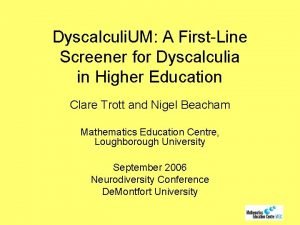
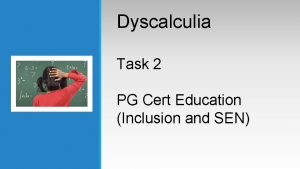
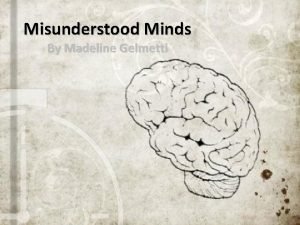
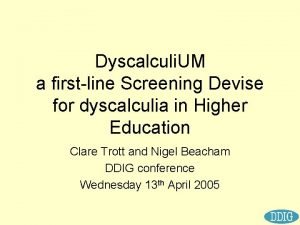


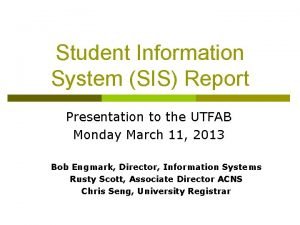

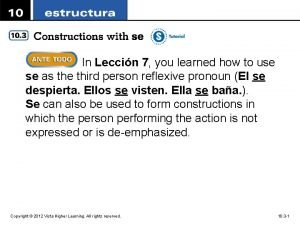
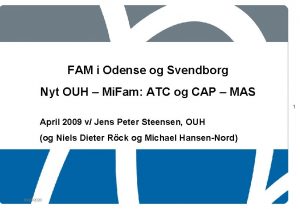
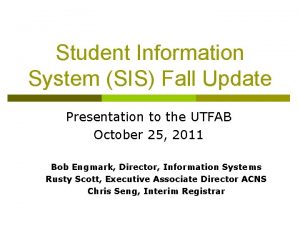
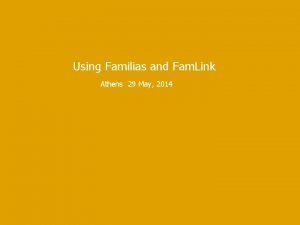

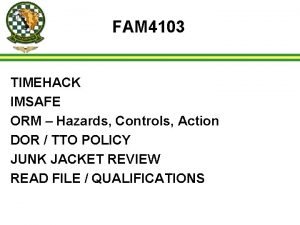
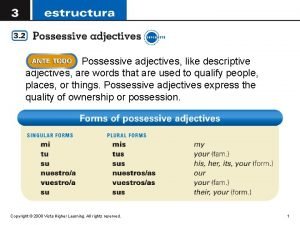
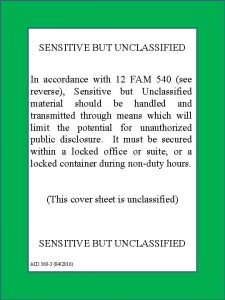

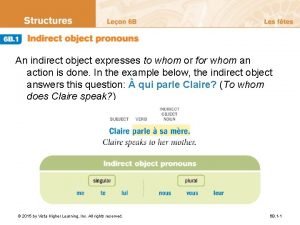
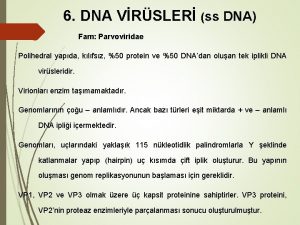
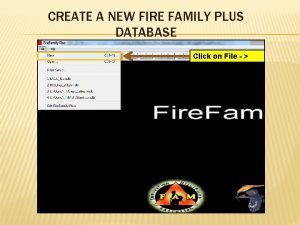

![(you [fam.] dropped) las pastillas. (you [fam.] dropped) las pastillas.](https://slidetodoc.com/wp-content/uploads/2021/02/3948728_11eb52afea26754ab90a65e7c62f281d-300x225.jpg)











































